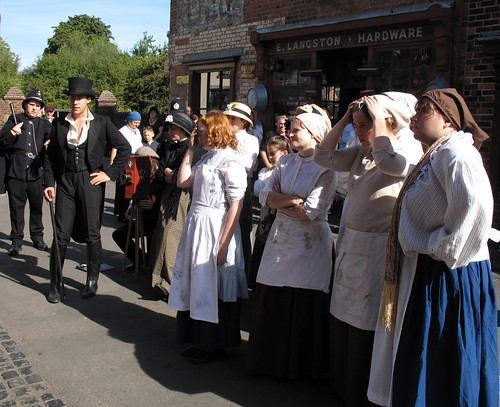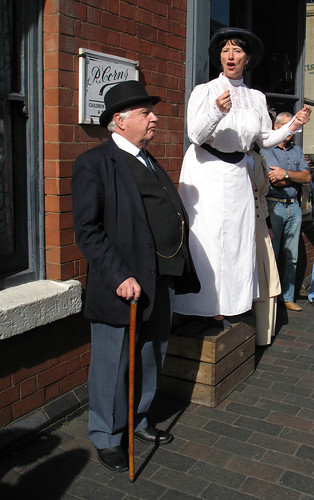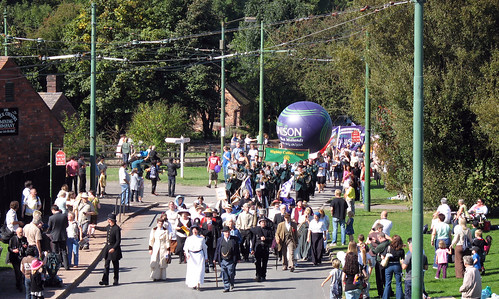 On Saturday 12th September I attended the 5th Women’s Chainmakers Festival with friends. The event took place at the Black Country Living Museum, Dudley and is held annually to commemorate the struggle of the women chainmakers to earn a decent living wage. This year’s festival celebrated the 99th anniversary of their success.
On Saturday 12th September I attended the 5th Women’s Chainmakers Festival with friends. The event took place at the Black Country Living Museum, Dudley and is held annually to commemorate the struggle of the women chainmakers to earn a decent living wage. This year’s festival celebrated the 99th anniversary of their success.
In 1910 the women chainmakers of Cradley Heath fought a successful 10 week dispute to establish a minimum wage for their labour. The dispute was led by union organiser and campaigner Mary MacArthur. By the end of the dispute the women chainmakers had managed to increase their earnings from 5 shillings (25p) to 11 shillings (55p). The victory helped to make the possibility of a national minimum wage a reality.
Women chainmakers were a good example of ’sweated labour’ meaning hours of toil for minimum wages. The women chainmakers’ pamphlet, which gives extensive information about the dispute, quotes the following about the working conditions of chainmakers:
Author Robert Harborough Sherard visited Cradley Heath to collect evidence for one of a series of articles, later published as a book ‘The White Slaves of England’ (1898), on the sweated trades of the land. He was taken by James Smith, secretary of the Chainmakers’ Union, to a place called Anvil Yard. Sherard Wrote:
“Two of the girls working in the shed were suckling babes and could work but slowly. Those who could work at their best being unencumbered could make a hundredweight of chain in two and a half days. Their owner walked serene and grey-haired among them, checking conversation, and being, at times, abusive. She was but one of a numerous class of human leeches fast to a gangrened sore.
Of Anvil Yard, with its open sewers and filth and shame, one would rather not write, nor of the haggard tatterdermalions* who groaned and jumped. In fact I hardly saw them, the name ‘Anvil Yard’ had set me thinking of some lines of Goethe, in which he deplores the condition of the people – ‘zwischen dem Amboss und Hammer’ – between the anvil and the hammer.
And as these lines went through my head, whilst before my spiritual eyes there passed the pale procession of the White Slaves of England, I could see nothing but sorrow and hunger and grime, rags, foul food, open sores and movements incessant, instinctive yet laborious – and anvil and a hammer ever descending – all vague, and in a mist as yet untinged with red, a spectacle so hideous that I gladly shut it out, wondering for my part, what in these things is right.”
*tatterdermalion – a poor and ragged person
The PCS Midlands office had a stall in the Leftfield tent, so there was a chance for me to meet up with friends old and new. It was also a great opportunity to explore the museum and give my camera an airing.
Throughout the day re-enactments of the struggle and dispute took place in the reconstructed town at the museum. These were followed by a march through the museum streets which was accompanied by marching bands and led by the costumed theatre group. This gave my friends and other trade unionists that were attending the event, the opportunity to join the march and display their branch and regional banners. At the end of the march a member of the theatre group read one of Mary MacArthur’s speeches to the crowd that had congregated during the march.
This was originally posted over at Nourishing Obscurity, the eagle eyed might notice that I have altered this version slightly to add a personal flavour. I will be posting more pictures of the day on my blog in due course, but if you want a sneaky preview of them all you can check here.










Thought I was seeing double for a moment.
Almost James It was necessary as lead up to my pics of the museum itself
It was necessary as lead up to my pics of the museum itself 
A very interesting slice of our history. I’m glad this struggle has not been forgotten.
We have to remember these things so the same mistakes aren’t made again.
Interesting… it’s the first I’ve heard of women chainmakers. Shows the importance of unions to change things…
I find all these old occupations very interesting. I came across lots when doing my family history research.
Great post, Cherie. Thank you for illustrating so well this often forgotten piece of our history. I’m glad to see the work of these women is commemorated. The struggle’s STILL vitally important: those ‘human leeches’ may vary but they continue to thrive (latest bunch enjoying huge bonuses once more …).
It does seem that history keeps repeating itself, but some people think we shouldn’t fight back against these injustices. Then they carrying on moaning about it, I find that quite strange.
What a fascinating picture of our history! Seems light years away doesn’t it?
It does, but on Saturday I felt like I had stepped back in time
An interesting post Cherie. Never heard or knew of chainmakers.
Thank goodness for unions. At least in those days they cared somewhat about the workers and not so much about filling their pockets.
I found some very interesting trades whilst researching my family history. One of the ones I like the most is sail cloth maker. I can just imagine my ancestor on the coast sitting sewing cloth by hand.
[...] for for inspiration for this theme, when I suddenly remembered that there was lots of music at the Women’s Chainmakers festival that I attended in September.